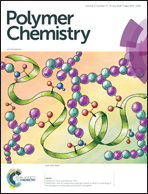Post-synthetic functionalization of a polysulfone scaffold with hydrazone-linked functionality†
Abstract
The synthesis, characterization, and post-synthetic functionalization of a readily functionalized step-growth linear polymer derived from divinyl sulfone (DVS) and tert-butylcarbazate (TBC) is presented. Construction of this atom-economic polymer under thermal conditions proceeds in high yield (>94%) at 75 °C, achieving a number average molecular weight of 17.0 kDa, a weight-average molecular weight of 26.2 kDa, and a polydispersity of 1.54, corresponding to a number-average degree of polymerization >60, despite the step-growth nature of the reaction. Removal of the Boc-groups yields a polymeric scaffold with hydrazine moieties that are readily reacted with aldehydes to yield the corresponding functional polyhydrazone materials. A variety of hydrazone-linked functionalities are readily added under mild conditions, including cationic, anionic, electron-rich/poor, and hetereoatom-containing aromatics. Owing to its rapid functionalization and simple and scalable synthesis, this material is an accommodating and generalized polymer scaffold that is rapidly tailored to a variety of applications with easily introduced functionality.



 Please wait while we load your content...
Please wait while we load your content...